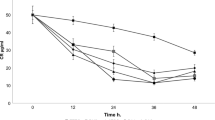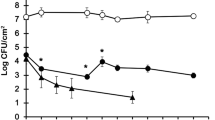Abstract
Human infection by bacteria of the genus Legionella most often result in the pneumonia known as Legionnaires Disease. Legionella is found as a resident of adherent biofilms in man-made water systems. Disinfection efforts to prevent Legionella infections require a better understanding of the structures that promote Legionella surface attachment and biofilm colonization. Various enzymatic treatments, including multiple carbohydrate-targeting mixtures, failed to disrupt Legionella biofilms, despite the presence of carbohydrates in the biofilms as shown by biochemical methods and concanavalin-A lectin staining. Moreover, Legionella biofilms contained amyloids as detected by three microscopic staining methods (congo red, thioflavin T, and the amyloid-specific antibody WO2). Amyloid structures were seen in biofilms of both L. pneumophila and L. longbeachae, the two Legionella species most associated with human infection. Inhibition of amyloid assembly by congo red and thioflavin T limited both self-aggregation and surface attachment of L. pneumophila, indicating that functional amyloid structures have a key role in initial biofilm formation by these pathogenic bacteria.


Similar content being viewed by others
References
Neil K, Berkelman R (2008) Increasing incidence of legionellosis in the United States, 1990–2005: changing epidemiologic trends. Clin Infect Dis Off Publ Infect Dis Soc Am 47:591–599. https://doi.org/10.1086/590557
Gargano JW (2013) Surveillance for waterborne disease outbreaks associated with drinking water and other nonrecreational water—United States, 2009–2010. Morb Mortal Wkly Rep 62:714–720
Fields BS, Benson RF, Besser RE (2002) Legionella and Legionnaires’ Disease: 25 years of investigation. Clin Microbiol Rev 15:506–526. https://doi.org/10.1128/CMR.15.3.506-526.2002
Srinivasan S, Harrington GW, Xagoraraki I, Goel R (2008) Factors affecting bulk to total bacteria ratio in drinking water distribution systems. Water Res 42:3393–3404. https://doi.org/10.1016/j.watres.2008.04.025
García MT, Baladrón B, Gil V, Tarancon ML, Vilasau A, Ibañez A, Elola C, Pelaz C (2008) Persistence of chlorine-sensitive Legionella pneumophila in hyperchlorinated installations. J Appl Microbiol 105:837–847. https://doi.org/10.1111/j.1365-2672.2008.03804.x
Thomas V, Bouchez T, Nicolas V, Robert S, Loret JF, Lévi Y (2004) Amoebae in domestic water systems: resistance to disinfection treatments and implication in Legionella persistence. J Appl Microbiol 97:950–963. https://doi.org/10.1111/j.1365-2672.2004.02391.x
Jiao Y, Cody GD, Harding AK, Wilmes P, Schrenk M, Wheeler KE, Banfield JF, Thelen MP (2010) Characterization of extracellular polymeric substances from acidophilic microbial biofilms. Appl Environ Microbiol 76:2916–2922. https://doi.org/10.1128/AEM.02289-09
Sutherland IW (2001) Biofilm exopolysaccharides: a strong and sticky framework. Microbiology 147:3–9
Bigot R, Bertaux J, Frère J, Berjeaud J-M (2013) Intra-amoeba multiplication induces chemotaxis and biofilm colonization and formation for Legionella. PLoS ONE 8:e77875. https://doi.org/10.1371/journal.pone.0077875
Cegelski L, Pinkner JS, Hammer ND, Cusumano CK, Hung CS, Chorell E, Åberg V, Walker JN, Seed PC, Almqvist F, Chapman MR, Hultgren SJ (2009) Small-molecule inhibitors target Escherichia coli amyloid biogenesis and biofilm formation. Nat Chem Biol 5:913–919. https://doi.org/10.1038/nchembio.242
Thallinger B, Prasetyo EN, Nyanhongo GS, Guebitz GM (2013) Antimicrobial enzymes: an emerging strategy to fight microbes and microbial biofilms. Biotechnol J 8:97–109. https://doi.org/10.1002/biot.201200313
Molobela IP, Cloete TE, Beukes M (2010) Protease and amylase enzymes for biofilm removal and degradation of extracellular polymeric substances (EPS) produced by Pseudomonas fluorescens bacteria. Afr J Microbiol Res 4:1515–1524
Stiefel P, Mauerhofer S, Schneider J, Maniura-Weber K, Rosenberg U, Ren Q (2016) Enzymes enhance biofilm removal efficiency of cleaners. Antimicrob Agents Chemother 60:3647–3652. https://doi.org/10.1128/AAC.00400-16
Johansen C, Falholt P, Gram L (1997) Enzymatic removal and disinfection of bacterial biofilms. Appl Environ Microbiol 63:3724–3728
Jordal PB, Dueholm MS, Larsen P, Petersen SV, Enghild JJ, Christiansen G, Højrup P, Nielsen PH, Otzen DE (2009) Widespread abundance of functional bacterial amyloid in mycolata and other gram-positive bacteria. Appl Environ Microbiol 75:4101–4110. https://doi.org/10.1128/AEM.02107-08
Larsen P, Nielsen JL, Dueholm MS, Wetzel R, Otzen D, Nielsen PH (2007) Amyloid adhesins are abundant in natural biofilms. Environ Microbiol 9:3077–3090
Larsen P, Nielsen JL, Otzen D, Nielsen PH (2008) Amyloid-like adhesins produced by floc-forming and filamentous bacteria in activated sludge. Appl Environ Microbiol 74:1517–1526. https://doi.org/10.1128/AEM.02274-07
Ramsook CB, Tan C, Garcia MC, Fung R, Soybelman G, Henry R, Litewka A, O’Meally S, Otoo HN, Khalaf RA, Dranginis AM, Gaur NK, Klotz SA, Rauceo JM, Jue CK, Lipke PN (2010) Yeast cell adhesion molecules have functional amyloid-forming sequences. Eukaryot Cell 9:393–404. https://doi.org/10.1128/EC.00068-09
Chatfield CH, Cianciotto NP (2007) The secreted pyomelanin pigment of Legionella pneumophila confers ferric reductase activity. Infect Immun 75:4062–4070. https://doi.org/10.1128/IAI.00489-07
Edelstein PH, Edelstein MA (1993) Comparison of three buffers used in the formulation of buffered charcoal yeast extract medium. J Clin Microbiol 31:3329–3330
Pécastaings S, Roques C (2013) Production of L. pneumophila monospecies biofilms in a low-nutrient-concentration medium. Methods Mol Biol 954:219–224. https://doi.org/10.1007/978-1-62703-161-5_12
Miqueleto AP, Dolosic CC, Pozzi E, Foresti E, Zaiat M (2010) Influence of carbon sources and C/N ratio on EPS production in anaerobic sequencing batch biofilm reactors for wastewater treatment. Bioresour Technol 101:1324–1330. https://doi.org/10.1016/j.biortech.2009.09.026
Thompson LJ, Gray V, Lindsay D, von Holy A (2006) Carbon: nitrogen : phosphorus ratios influence biofilm formation by Enterobacter cloacae and Citrobacter freundii. J Appl Microbiol 101:1105–1113. https://doi.org/10.1111/j.1365-2672.2006.03003.x
Chapman MR, Robinson LS, Pinkner JS, Roth R, Heuser J, Hammar M, Normark S, Hultgren SJ (2002) Role of Escherichia coli curli operons in directing amyloid fiber formation. Science 295:851–855. https://doi.org/10.1126/science.1067484
Zhou Y, Blanco LP, Smith DR, Chapman MR (2012) Bacterial amyloids. Methods Mol Biol 849:303–320. https://doi.org/10.1007/978-1-61779-551-0_21
Watanabe M KS (1998) Growth and flocculation of a marine photosynthetic bacterium Rhodovulum sp. Appl Microbiol Biotechnol 50:682–691. https://doi.org/10.1007/s002530051351
Syed S, Riyaz-Ul-Hassan S, Johri S (2013) A novel cellulase from an endophyte, Penicillium sp. NFCCI 2862. Am J Microbiol Res 1:84–91. https://doi.org/10.12691/ajmr-1-4-4
Priya V, Sashi V (2014) Pectinase enzyme producing microorganisms. Int J Sci Res Publ 4:1–3
Wandersman C, Andro T, Bertheau Y (1986) Extracellular proteases in Erwinia chrysanthemi. J Gen Microbiol 132:899–906
Hamilton M (2003) The biofilm laboratory: step-by-step protocols for experimental design, analysis, and data interpretation. Cytergy Pub., Bozeman
Westermark GT, Johnson KH, Westermark P (1999) Staining methods for identification of amyloid in tissue. Methods Enzymol 309:3–25
Picken MM, Herrera GA (2012) Thioflavin T stain: an easier and more sensitive method for amyloid detection. In: Picken MM, Dogan A, Herrera GA (eds) Amyloid and related disorders. Humana Press, New York pp 187–189
Al-Fattani MA, Douglas LJ (2006) Biofilm matrix of Candida albicans and Candida tropicalis: chemical composition and role in drug resistance. J Med Microbiol 55:999–1008. https://doi.org/10.1099/jmm.0.46569-0
Pécastaings S, Bergé M, Dubourg KM, Roques C (2010) Sessile Legionella pneumophila is able to grow on surfaces and generate structured monospecies biofilms. Biofouling 26:809–819. https://doi.org/10.1080/08927014.2010.520159
Biancalana M, Koide S (2010) Molecular mechanism of thioflavin-T binding to amyloid fibrils. Biochim Biophys Acta 1804:1405–1412. https://doi.org/10.1016/j.bbapap.2010.04.001
Schwartz K, Syed AK, Stephenson RE, Rickard AH, Boles BR (2012) Functional amyloids composed of phenol soluble modulins stabilize Staphylococcus aureus biofilms. PLOS Pathog 8:e1002744. https://doi.org/10.1371/journal.ppat.1002744
Yu VL, Plouffe JF, Pastoris MC, Stout JE, Schousboe M, Widmer A, Summersgill J, File T, Heath CM, Paterson DL, Chereshsky A (2002) Distribution of Legionella species and serogroups isolated by culture in patients with sporadic community-acquired legionellosis: an international collaborative survey. J Infect Dis 186:127–128. https://doi.org/10.1086/341087
Karpova TI, Dronina IE, Alekseeva NV, Romanova IM, Tartakovskiĭ IS (2008) [Biofilm formation by Legionella spp. in experiment]. Zh Mikrobiol Epidemiol Immunobiol 3–7
Abdel-Nour M, Duncan C, Prashar A, Rao C, Ginevra C, Jarraud S, Low DE, Ensminger AW, Terebiznik MR, Guyard C (2014) The Legionella pneumophila collagen-like protein mediates sedimentation, autoaggregation, and pathogen-phagocyte interactions. Appl Environ Microbiol 80:1441–1454. https://doi.org/10.1128/AEM.03254-13
Lorenzo A, Yankner BA (1994) Beta-amyloid neurotoxicity requires fibril formation and is inhibited by congo red. Proc Natl Acad Sci USA 91:12243–12247
Watson DJ, Lander AD, Selkoe DJ (1997) Heparin-binding properties of the amyloidogenic peptides Aβ and amylin: dependence on aggregation state and inhibition by congo red. J Biol Chem 272:31617–31624. https://doi.org/10.1074/jbc.272.50.31617
Garcia MC, Lee JT, Ramsook CB, Alsteens D, Dufrêne YF, Lipke PN (2011) A role for amyloid in cell aggregation and biofilm formation. PLoS ONE 6:e17632. https://doi.org/10.1371/journal.pone.0017632
Oli MW, Otoo HN, Crowley PJ, Heim KP, Nascimento MM, Ramsook CB, Lipke PN, Brady LJ (2012) Functional amyloid formation by Streptococcus mutans. Microbiol Read Engl 158:2903–2916. https://doi.org/10.1099/mic.0.060855-0
Augustin M, Ali-Vehmas T, Atroshi F (2004) Assessment of enzymatic cleaning agents and disinfectants against bacterial biofilms. J Pharm Pharm Sci Publ Can Soc Pharm Sci Soc Can Sci Pharm 7:55–64
Chaignon P, Sadovskaya I, Ragunah C, Ramasubbu N, Kaplan JB, Jabbouri S (2007) Susceptibility of staphylococcal biofilms to enzymatic treatments depends on their chemical composition. Appl Microbiol Biotechnol 75:125–132. https://doi.org/10.1007/s00253-006-0790-y
Niazi SA, Al-Ali WM, Patel S, Foschi F, Mannocci F (2015) Synergistic effect of 2% chlorhexidine combined with proteolytic enzymes on biofilm disruption and killing. Int Endod J 48:1157–1167. https://doi.org/10.1111/iej.12420
Singh V, Verma N, Banerjee B, Vibha K, Haque S, Tripathi CKM (2015) Enzymatic degradation of bacterial biofilms using Aspergillus clavatus MTCC 1323. Microbiology 84:59–64. https://doi.org/10.1134/S0026261715010130
Limoli DH, Jones CJ, Wozniak DJ (2015) Bacterial extracellular polysaccharides in biofilm formation and function. Microbiol Spectr. https://doi.org/10.1128/microbiolspec.MB-0011-2014
Cianciotto NP, White RC (2017) Expanding role of Type II secretion in bacterial pathogenesis and beyond. Infect Immun 85. https://doi.org/10.1128/IAI.00014-17
Thorpe TC, Miller RD (1981) Extracellular enzymes of Legionella pneumophila. Infect Immun 33:632–635
Duncan C, Prashar A, So J, Tang P, Low DE, Terebiznik M, Guyard C (2011) Lcl of Legionella pneumophila is an immunogenic GAG binding adhesin that promotes interactions with lung epithelial cells and plays a crucial role in biofilm formation. Infect Immun 79:2168–2181. https://doi.org/10.1128/IAI.01304-10
Mallegol J, Duncan C, Prashar A, So J, Low DE, Terebeznik M, Guyard C (2012) Essential roles and regulation of the Legionella pneumophila collagen-like adhesin during biofilm formation. PloS One 7:e46462. https://doi.org/10.1371/journal.pone.0046462
Azeredo J, Lazarova V, Oliveira R (1999) Methods to extract the exopolymeric matrix from biofilms: a comparative study. Water Sci Technol 39:243
Pham CLL, Kwan AH, Sunde M (2014) Functional amyloid: widespread in nature, diverse in purpose. Essays Biochem 56:207–219. https://doi.org/10.1042/bse0560207
Zhou Y, Smith D, Leong BJ, Brännström K, Almqvist F, Chapman MR (2012) Promiscuous cross-seeding between bacterial amyloids promotes interspecies biofilms. J Biol Chem 287:35092–35103. https://doi.org/10.1074/jbc.M112.383737
Blanco LP, Evans ML, Smith DR, Badtke MP, Chapman MR (2012) Diversity, biogenesis and function of microbial amyloids. Trends Microbiol 20:66–73. https://doi.org/10.1016/j.tim.2011.11.005
DePas WH, Chapman MR (2012) Microbial manipulation of the amyloid fold. Res Microbiol 163:592–606. https://doi.org/10.1016/j.resmic.2012.10.009
Acknowledgements
The authors thank the SUNY Cortland Undergraduate Research Council for funding this research and NSF grant 1337695. We would like to thank Ronald Wetzel (WO2 antibody) and Matthew Chapman (Curli-deficient and WT E. coli strains) for reagents. We kindly thank Kessler McCoy-Simandle for assistance in preparation of this manuscript.
Author information
Authors and Affiliations
Corresponding author
Ethics declarations
Conflict of interest
The authors declare that they have no conflict of interest.
Additional information
Casey P. Peterson and Christa H. Chatfield have contributed equally to this work.
Electronic supplementary material
Below is the link to the electronic supplementary material.
Supplemental figure 1: Functional amyloid staining controls in
Escherichia coli curli-forming strain MC4100 and the curli- deficient csgA mutant. In each row, the first image shows DAPI staining for E. coli MC4100 (a, b and c) or csgA mutant (d) cultures. The second image in each row shows amyloid staining by (a) congo red (b) thioflavin T and (c) WO2 antibody in MC4100 biofilm. Row (d) shows thioflavin T results for the csgA mutant. The third image in each row is the overlay of the two images. Each image was obtained at 40x magnification and is representative of at least two independent replicates. (TIF 32795 KB)
Supplemental figure 2: Functional amyloid are in
L. longbeachae MSBB biofilms. In each row, the first image shows DAPI staining for Llo in MSBB biofilms at day 3 post inoculation. The second image in each row shows amyloid staining by (a) congo red (b) thioflavin T and (c) WO2 antibody (scale bar = 20 µm). The third image in each row is the overlay of the two images. Each image was obtained at 40x magnification and is representative of at least two independent replicates. (TIF 37736 KB)
Rights and permissions
About this article
Cite this article
Peterson, C.P., Sauer, C. & Chatfield, C.H. The Extracellular Polymeric Substances of Legionella pneumophila Biofilms Contain Amyloid Structures. Curr Microbiol 75, 736–744 (2018). https://doi.org/10.1007/s00284-018-1440-1
Received:
Accepted:
Published:
Issue Date:
DOI: https://doi.org/10.1007/s00284-018-1440-1




